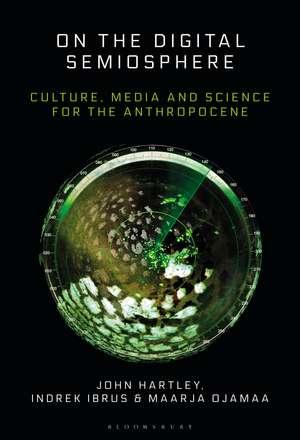On the Digital Semiosphere: Culture, Media and Science for the Anthropocene
Autor Prof. John Hartley, Professor Indrek Ibrus, Dr. Maarja Ojamaaen Limba Engleză Paperback – 27 iul 2022
| Toate formatele și edițiile | Preț | Express |
|---|---|---|
| Paperback (1) | 200.61 lei 6-8 săpt. | |
| Bloomsbury Publishing – 27 iul 2022 | 200.61 lei 6-8 săpt. | |
| Hardback (1) | 571.50 lei 6-8 săpt. | |
| Bloomsbury Publishing – 23 dec 2020 | 571.50 lei 6-8 săpt. |
Preț: 200.61 lei
Preț vechi: 259.39 lei
-23% Nou
Puncte Express: 301
Preț estimativ în valută:
38.39€ • 41.69$ • 32.25£
38.39€ • 41.69$ • 32.25£
Carte tipărită la comandă
Livrare economică 22 aprilie-06 mai
Preluare comenzi: 021 569.72.76
Specificații
ISBN-13: 9781501369216
ISBN-10: 1501369210
Pagini: 360
Ilustrații: 28 bw illus
Dimensiuni: 152 x 229 x 23 mm
Greutate: 0.49 kg
Editura: Bloomsbury Publishing
Colecția Bloomsbury Academic
Locul publicării:New York, United States
ISBN-10: 1501369210
Pagini: 360
Ilustrații: 28 bw illus
Dimensiuni: 152 x 229 x 23 mm
Greutate: 0.49 kg
Editura: Bloomsbury Publishing
Colecția Bloomsbury Academic
Locul publicării:New York, United States
Caracteristici
Locates culture within the history of sciences, both methodological (accommodating evolution, complex systems and data analytics) and disciplinary (connecting Lotman's semiosphere and Vernadsky's biosphere), synthesising humanities and science to face the challenges of the advancing Anthropocene
Notă biografică
John Hartley is John Curtin Distinguished Professor at Curtin University, Australia; previously founding Dean of Creative Industries at QUT, inaugural Head of the School of Journalism, Media and Cultural Studies at Cardiff University, Wales. He has published over 30 books on cultural, media, communication and journalism studies, and more recently creative economy and cultural science, with Google Scholar citations approaching 40,000.Indrek Ibrus is Professor at Tallinn University, Estonia and the head of Center of Excellence in Media Innovation and Digital Culture (MEDIT: http://medit.tlu.ee/). His main strand of research is media innovation and the co-evolutionary effects of textual, social and economic dynamics in shaping the new forms of media. He is the co-editor (with Carlos Scolari) of Crossmedia Innovations: Texts, Markets, Institutions (2012).Maarja Ojamaa is a research fellow at Tallinn University, Estonia and a member of MEDIT (http://medit.tlu.ee/). Her research has followed the paradigm of Lotmanian cultural semiotics, exploring transmediality, both on the micro level as a textual phenomenon and on the macro level as a mechanism of cultural auto-communication. Her work has been published in the International Journal of Cultural Studies, Sign System Studies, International Journal of Communication.
Cuprins
Part I. Spheres and Globes 1: A Semiotic Theory of Spheres2: A Short History of Globes3: Juri Lotman and Cultural SemioticsPart II. Elements of the Digital Semiosphere4: 'Inside Thinking Worlds'5: Dialogue and Dynamics6: Cultural Semiotics in a Multidisciplinary Environment Part III. Micro-scale: Text7: What Does Culture Want?8: Text, Transmission, Translation9: Text, Creation, Newness10: Text, Preservation, MemoryPart IV. Meso-scale: Institution 11: Planetary Systems of Culture Production12: Bubbles: Production of Continual Systems13: Blows: Production of Discontinuities14: Foam: Production of Dynamic MultiplicityPart V. Macro-scale: System 15: Globe: Production of Digital Distinctions16: The Digital Semiosphere and the Technosphere17: Semiosis: Regulating Politics and Economics18: Staged Conflict: New Demes and ClassesPart VI. Cultural Science for the Anthropocene 19: Populations of Rules: The Constitution and Coordination of Media-made Groups20: Where to Now, Planet?ReferencesAcknowledgementsIndex
Recenzii
The monograph of Hartley, Ibrus and Ojamaa is an excellent starting point for the future of digital semiotics. The exceptional merit of these authors is to open the semiotic science of culture up to the economic/commercial dimension of digital culture. This had been completely ignored by previous contributions and allows for the multidimensional analysis of a wide variety of specific manifestations of new technologies and communication practices.
In this book, John Hartley, Indrek Ibrus, and Maarja Ojamaa pass on the shining torch of Lotman's 20th century vision of cultural semiospheres that still had centers and peripheries to the generations of the Anthropocene facing new digital and global realities, which the authors illuminate with their advanced semiotic instrumentarium.
In this book, John Hartley, Indrek Ibrus, and Maarja Ojamaa pass on the shining torch of Lotman's 20th century vision of cultural semiospheres that still had centers and peripheries to the generations of the Anthropocene facing new digital and global realities, which the authors illuminate with their advanced semiotic instrumentarium.
